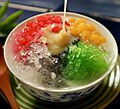Edible seaweed

Edible seaweed, or sea vegetables, are
Most edible seaweeds are marine algae whereas most freshwater algae are toxic. Some marine algae contain acids that irritate the digestion canal, while others can have a
Distribution
Seaweeds are used extensively as food in coastal cuisines around the world, particularly in
Seaweed is also consumed in many traditional European societies, in Iceland and western Norway, the Atlantic coast of France, northern and western Ireland, Wales and some coastal parts of South West England,[14] as well as New Brunswick, Nova Scotia, and Newfoundland and Labrador. Cooking with seaweed flakes has become more and more popular in the western hemisphere.[15]
Nutrition and uses

Seaweeds are a good source of nutrients such as proteins, vitamins, minerals, and dietary fiber. Polyphenols, polysaccharides, and sterols, as well as other bioactive molecules, are mainly responsible for the healthy properties associated with seaweed. If seaweeds are compared to terrestrial plants, they have a higher proportion of essential fatty acids as eicosapentaenoic (EPA) and docosahexaenoic (DHA) fatty acids.[16]
Seaweed contains high levels of iodine, tyrosine relative to other foods.[17] It is also rich in calcium and magnesium.[18]
Seaweed is a possible vegan source of Vitamin B12.[19] The vitamin is obtained from symbiotic bacteria.[20] However, the Academy of Nutrition and Dietetics considers seaweed to be an unreliable source of Vitamin B12 for human nutrition.[21]
Seaweed are used in multiple cuisines:
- seaweed (Nori) wrapped sushi, maki
- seaweed in soup, stew, hot pot
- seaweed in salad
- seaweed snacks (eg. Tong Garden, Dae Chun Gim)
- seaweed in instant noodles (eg. Jongga, Four Seas, Nongshim)
Non-human feed:
- seaweed as food for livestock[22]
- seaweed as food for fish (aquariums & fish farms)
Seaweeds are rich in polysaccharides that could potentially be exploited as prebiotic functional ingredients for both human and animal health applications. Prebiotics are non-digestible, selectively fermented compounds that stimulate the growth and/or activity of beneficial gut microbiota which, in turn, confer health benefits on the host.[23] In addition, there are several secondary metabolites that are synthesized by algae such as terpenoids, oxylipins, phlorotannins, volatile hydrocarbons, and products of mixed biogenetic origin. Therefore, algae can be considered as a natural source of great interest, since they contain compounds with numerous biological activities and can be used as a functional ingredient in many technological applications to obtain functional foods. Polysaccharides in seaweed may be metabolized in humans through the action of bacterial gut enzymes. Such enzymes are frequently produced in Japanese population due to their consumption of seaweeds.[24]
As a
Feeding the seaweed Asparagopsis taxiformis to cows can reduce their methane emissions.[26]
East Asia
In some parts of Asia,
Japanese cuisine has common names for seven types of seaweed, and thus the term for seaweed in Japanese is used primarily in scientific applications, and not in reference to food.
The dish often served in western Chinese restaurants as 'Crispy Seaweed' is not seaweed but cabbage that has been dried and then fried.[29]
-
Dasima (kelp)
-
Cakes and Food Made of Seaweed by Kubo Shunman, 19th century
-
Okinawa
Southeast Asia
Numerous other species of seaweeds are traditionally eaten in Southeast Asia, mainly in the Philippines, but also in
In the Philippines, a traditional ingredient is
Seaweed is also processed into noodles by residents of
-
A disc of dried gamet from the Philippines
-
Sea grapes (Caulerpa lentillifera) were originally cultivated in the Philippines. They are usually eaten raw with vinegar, as a snack or in a salad.[40]
-
Gusô (Eucheuma spp.), another edible tropical seaweed species originally cultivated in the Philippines. They are eaten fresh, similar to sea grapes, or processed into carrageenan.
-
Buko pandan, a dessert beverage from the Philippines made with pandan-flavored cubes of gulaman, a traditional jelly-like ingredient made from agar or carrageenan
Common edible seaweeds
Common edible seaweeds[41][10][42] include:
See also
- Aquaculture of giant kelp – Cultivation of seaweed
- Seaweed farming – Farming of aquatic seaweed
- Seaweed oil
References
- PMID 35820048.
- ^ S2CID 82049384.
- .
- S2CID 10531419.
- ^ Round F.E. 1962 The Biology of the Algae. Edward Arnold Ltd.
- PMID 28865623.
- ^ Wiseman, John SAS Survival Handbook
- ^ OCLC 747112294.
- ISBN 978-0-7216-2921-6.
- ^ a b c d e Zaneveld, Jacques S. (1959). "The Utilization of Marine Algae in Tropical South and East Asia". Economic Botany. 13 (2): 89–131.
- ^ "Seaweed as Human Food". Michael Guiry's Seaweed Site. Retrieved 2011-11-11.
- ^ "Kai Recipe's used by Kawhia Maori & Early Pioneers". Kawhia.maori.nz. Retrieved 2011-11-11.
- S2CID 22620932.
- ^ "Spotlight presenters in a lather over laver". BBC. 2005-05-25. Retrieved 2011-11-11.
- ^ "Famadillo - How to use seaweed flakes". Archived from the original on 12 April 2023.
- PMID 32517092.
- ^ "Micronutrient Information Center: Iodine". Oregon State University: Linus Pauling Institute. 2014-04-23. Retrieved 2011-11-11.
- ABS-CBN Regional Network Group. 2008-04-08. Retrieved 2009-08-04.
- PMID 24803097.
- PMID 17434786.
- S2CID 4984228.
Fermented foods (such as tempeh), nori, spirulina, chlorella algae, and unfortified nutritional yeast cannot be relied upon as adequate or practical sources of B-12.39,40 Vegans must regularly consume reliable sources—meaning B-12 fortified foods or B-12 containing supplements—or they could become deficient, as shown in case studies of vegan infants, children, and adults.
- .
- PMID 20714423.
- S2CID 2820027.
- OCLC 5707377199. Archivedfrom the original on September 3, 2020.
- ^ Milman, Oliver (2021-03-18). "Feeding cows seaweed could cut their methane emissions by 82%, scientists say". The Guardian. Archived from the original on 2021-03-18. Retrieved 2021-11-24.
- ^ Nunez, Kirsten (31 December 2019). "4 Gelatin Substitutes Every Vegan or Vegetarian Needs to Try". Clean Green Simple. Retrieved 11 November 2021.
- ^ Mary Jo Zimbro; David A. Power; Sharon M. Miller; George E. Wilson; Julie A. Johnson (eds.). Difco & BBL Manual (PDF) (2nd ed.). Becton Dickinson and Company. p. 6. Archived from the original (PDF) on 2012-06-06. Retrieved 2013-07-17.
- ^ Hom, Ken (2012). "Crisp Seeweed". Good Food Channel. UK TV.CO.UK. Retrieved 16 October 2014.
- S2CID 15745994.
- ^ Adriano, Leilanie G. (21 December 2005). "'Gamet' sushi festival launched". The Manila Times. Retrieved 15 August 2021.
- ^ "Gamet". Museo Ilocos Norte. 28 May 2016. Retrieved 15 August 2021.
- ^ "Cagayan town passes seaweed protection law". The Manila Times. 15 December 2013. Retrieved 15 August 2021.
- ^ de Noceda, Juan; de Sanlucar, Pedro (1754). Vocabulario de la lengua Tagala. Imprenta de la compañia de Jesus. pp. 101, 215.
- ^ de Mentrida, Alonso (1841). Diccionario De La Lengua Bisaya, Hiligueina Y Haraya de la isla de Panay. En La Imprenta De D. Manuel Y De D. Felis Dayot. p. 380.
- ^ Marine Plants Section, National Fisheries Research and Development Institute. Gracilaria species in the Philippines (PDF). Bureau of Fisheries and Aquatic Resources, Department of Agriculture, Republic of the Philippines. Retrieved 12 March 2024.
- ^ Albert H. Wells (1916). "Possibilities of Gulaman Dagat as a Substitute for Gelatin in Food". The Philippine Journal of Science. 11: 267–271.
- ^ Montaño, Marco Nemesio E. (16 September 2004). "Gelatin, gulaman, 'JellyAce,' atbp". PhilStar Global. Retrieved 11 November 2021.
- ^ Blogger, Meridian Sea. "Cooking with Seaweed and the Health Benefits - Seaweed Varieties in UK". Meridian Sea Limited.
- ISBN 978-0-471-19208-4.
- ^ Harrison, M. (2008). "Edible Seaweeds around the British Isles". Wild Food School. Archived from the original on 2015-07-21. Retrieved 2011-11-11.
- .
External links
- Seaweeds used as human food an FAO report








![Sea grapes (Caulerpa lentillifera) were originally cultivated in the Philippines. They are usually eaten raw with vinegar, as a snack or in a salad.[40]](http://upload.wikimedia.org/wikipedia/commons/thumb/a/a3/USAID_Measuring_Impact_Conservation_Enterprise_Retrospective_%28Philippines%3B_Nagkakaisang_Tribu_ng_Palawan%29_%2826420465388%29.jpg/120px-USAID_Measuring_Impact_Conservation_Enterprise_Retrospective_%28Philippines%3B_Nagkakaisang_Tribu_ng_Palawan%29_%2826420465388%29.jpg)



